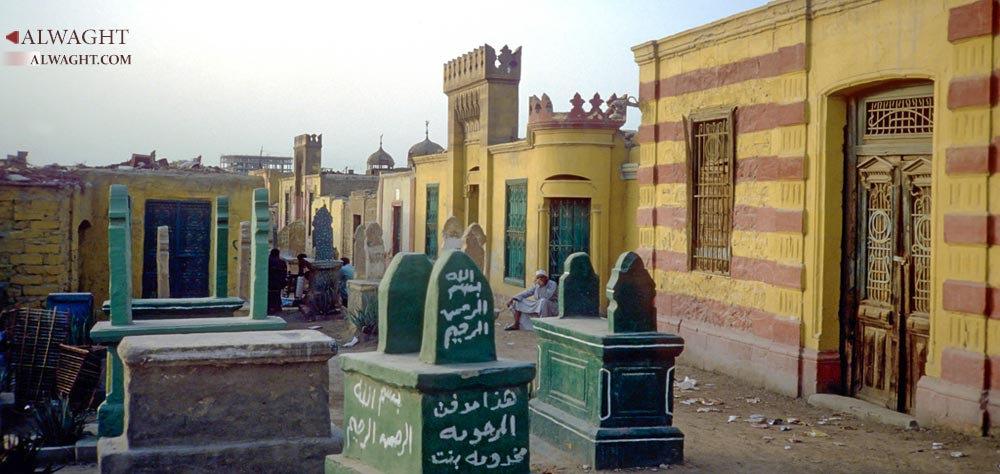Alwaght- Children play hide and seek behind the tombs, others maneuver a football to score past the invisible goal line demarcated by two graves. Women hang laundry across strings that extend across rooftops, sometimes from one gravestone to another. Some men bake bread for a living, others enjoy watching TV upon returning from a long day of work. Welcome to the City of the Dead, where among the graves there is life.
Southeast of Cairo, Egypt, in a neighborhood known as al-Arafa or more descriptively, the City of the Dead, half a million Egyptians live in an ancient necropolis turned into a residential neighborhood.
Multi-purpose Shelves
The cemetery dates to the seventh century, and is made up of a grid of mausoleum structures. Unusual in their forms, these structures have more of a resemblance to small houses than tombs. So, the down-trodden of Cairo decided to occupy these lifeless vaults to shelter themselves from homelessness. Migration, expensive housing, and natural disasters drove entire families to move into these tombs and generations to be born and brought up there.
These relatively new occupiers have refurbished the tiny rooms setting up kitchens, living rooms, and bathrooms. It seems that they don’t mind the company downstairs where dead bodies are “women are placed on shelves in separate underground rooms that are covered with stone slabs” in accordance with tradition.
Occasionally, one can see books and photo frames on the grave markers where the dead lie fast asleep, serving as shelves for ornaments and family possessions.
Grave Difficulties
At first, the idea of living in a cemetery seems acceptable because amid a fast growing population and a rise in housing prices in Cairo, impoverished Egyptians are looking for an alternative. Faced with no other option or ones that seem even less desirable than having corpses as roommates, many have preferred the affordable tombs to the expanding slums of the capital.
But living in a cemetery comes with many hardships.
In The City of the Dead, A History of Cairo’s Cemetery Communities, Jeffrey A. Nedoroscik explains the inconvenience of living in cemeteries.
“Of course there are disadvantages of living in the City of the Dead as opposed to living in other informal communities in Cairo. Residents of the City of the Dead are insecure about the status of their residences. Unlike some informal communities that the government has come to accept, the illegal society of the cemeteries has little hope of ever being fully recognized by the government and earning an official legal status,” he writes.
While the community does have access to electricity, running water, a medical center and even a post office and schools, these services are limited.
From vermin, to the smell of garbage, and even sewage leaks, the community faces disease risks.
In addition, in the near-absolute absence of police force, crime rates are high in the neighborhood not to mention the fact that residents can be evicted without notice by either the government or the owners of these tombs who in most cases rent them out.
“Given this predicament, the cemetery communities have little chance of bettering their access to such services as running water, sewage, and public education and health care,” Nedoroscik concludes.
Another problem that is attached to this lifestyle, is social stigma and discrimination. Dr Said Sadek, political sociologist at the American University in Cairo, told Ahram Online that “inhabitants from this locality have grown accustomed to being rejected by the middle and upper echelons of Egyptian society.”
Death Culture
The City of the Dead is an Islamic necropolis dating back to 642 AD. It was founded during the Islamic conquest of Egypt. From the Fatimids to the Ottomans, the deserted location was chosen as a burial ground by Egypt’s successive rulers.
The history of the place along with the Egyptian culture which has long revered the dead, as far back as the ancient civilizations of the pharaohs, combine to instil a sense of valued nearness to the ancestors of those who live in cemeteries, or so some claim.
It was actually an Egyptian custom to bury the dead in such rooms so that mourners could stay with them during a forty-day mourning period.
Even if it is not to this extent, the sense of eeriness normally felt with regards to such a place is not within the place but rather outside it. Today, the paradox of life in a cemetery is looked down upon, particularly on the urban end of the social strata.
Nedoroscik further explains why in previous times, people did not take a dim view of the inhabitation of cemeteries as opposed to modern-day Egyptian society which has been influenced by Western ethos.
“It has brought a more westernized attitude towards cemeteries in the Egyptian society, making the presence of people living and carrying out activities in the cemeteries ignored, condemned and shamed by the majority of Cairene society.”
The Ghost of Uncertainty
“I am not scared of the dead, I am scared of the living," Fatma, a mother of three told Ahram Online. The irony of the situation reveals how the real threat to this cemetery-dweller lies in the realm of existence and not in the spine-chilling stories of vengeful spirits and waking corpses.
With the population increasing due to migration and not enough accommodations being provided, the City of the Dead is forced to deal with a housing crisis. Yet, with nowhere else to go, residents –some whose families have lived there for hundreds of years—are not willing to relocate based on government demands. Their only option is to ask for housing in exchange for leaving. This means that their future remains undecided.
For these people, uncertainty is the ghost that haunts them.
There has always been a veil that separates the world of the living and the world of the dead. This shroud, appears to have been removed from the carcass of Egyptian culture, at least what remains of its traditions. With a total of 5 million poverty-stricken Egyptians living in the cemeteries of Cairo, cemeteries have become permanent homes for both the living and the dead.



























